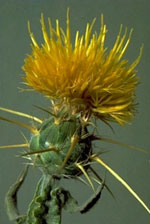Threats
to Birds - Yellow Starthistle (Centaurea solstitialis)
Overview
This native of Eurasia was introduced in the mid 1800's and spread from west coast ballast areas to 23 of the 48 contiguous states. Yellow starthistle is one of the top 10 worst weeds in California, Oregon, Washington, Arizona and Idaho, impacting tens of millions of acres. In California, the area infested has increased more than six times since 1958, affecting an estimated 17 million acres. Contaminated seed and feed are important sources of spread, and it has little value to native birds although it is eaten by ring-necked pheasants, California Quail, House Finches, and American Goldfinches. Yellow starthistle has eliminated thousands of acres of Long-billed Curlew breeding habitat, a species that has declined due to loss of prairie and meadow habitat. The plant develops a deep taproot which allows it to proliferate in dry areas. It reproduces exclusively by seed and forms dense stands. Production of allelochemicals prevents growth of native plants. It is poisonous to horses, causing the nervous disorder, “chewing disease.”
Description
Yellow starthistle is an annual or biennial with a deep taproot. It can grow 1 - 3 feet tall; stems are rigid and branched from the base; bushy, wooly, and grayish in color; basal leaves deeply lobed and clustered; upper leaves are narrow with smooth margins and sharply pointed; flower heads are urn-shaped; flowers are yellow with straw-colored thorns.
Birds Affected
Long-billed Curlew (breeding grounds); Sage Grouse; primary wintering grounds for Ross’s Geese, “Lesser” Sandhill Crane in Pacific flyway.
Control
Five natural enemies (two flies and three beetles) have been released for bio-control, which is viewed as the best long-term strategy for managing yellow starthistle. A rust fungus which attacks the foliage and young plants has recently been released in northern California and is being monitored. The most cost-effective way to manage yellow starthistle is to prevent its establishment by maintaining a healthy community of native or otherwise desireable plants, taking care not to import seed, carefully monitoring the land, especially road sides and disturbed areas, and eradicating new populations upon detection. Methods such as hand pulling, hoeing, weed whipping, tillage, mowing, and prescribed burning have been used with some success. |
